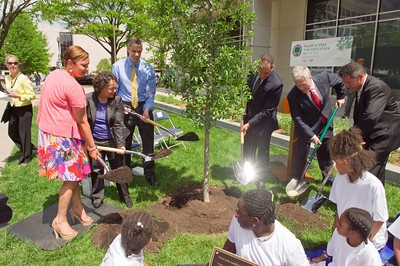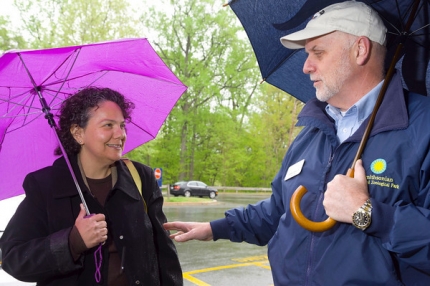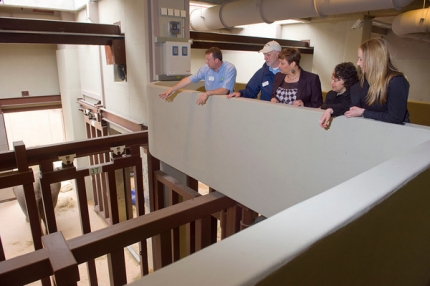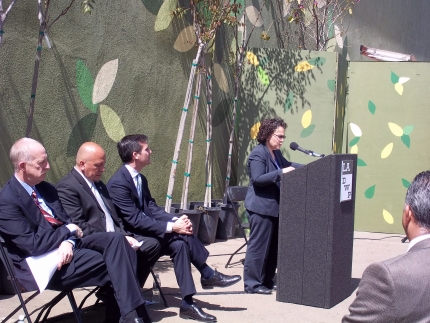Council on Environmental Quality Blog
A Clear Commitment to Clean Water for America
Posted by on April 27, 2011 at 2:59 PM EDTClean water is the foundation of healthy communities. It is vital to everyone, from families who want safe drinking water, to fishermen and women who want to know their catch is safe to eat, to farmers who rely on it to grow their crops, and everyone in between. We understand the importance of clean water and healthy watersheds to our economy, to our environment and to our families.
Clean water has been a priority for this Administration from day one. Through an extensive set of policies and initiatives, we are working across Federal agencies, across governments and across sectors to use every tool in our toolbox to make sure Americans have the clean and healthy waters they need and deserve.
Today, we released a national clean water framework that affirms the Obama Administration’s comprehensive commitment to ensuring clean water and healthy waterways for American families, American communities, and the American economy. We're taking strong action to reduce contaminants in our drinking water by using the latest science to update drinking water standards, and by better protecting drinking water sources from pollution. We’re giving farmers incentives to reduce pollution, and giving landowners incentives to open up their lands for fishing, swimming, and other activities that promote public stewardship of our waters. We're working with states to make sure rural communities have affordable and modern clean water systems.
Learn more about Energy and EnvironmentCultivating the Seeds of Knowledge; Growing a Greener Future for our Nation
Posted by on April 26, 2011 at 5:50 PM EDTAs the bitter chill of winter retreats, the vibrancy of spring beckons us outdoors reminding us of the inextricable link between the natural world and our daily lives. In striving to meet the President's challenge to win the future by out-educating the rest of the world, we must cultivate the environmental health of our learning spaces and our students’ understanding of their environment to enable them to meet the challenges of the future. Today, the Department of Education, the Environmental Protection Agency, and the White House Council on Environmental Quality came together to launch the Green Ribbon Schools Program. This program plants the seeds to move toward educational excellence for the future by recognizing schools that are creating healthy and sustainable learning environments - both inside and outside the classroom, teaching environmental literacy, and increasing environmental health by reducing their environmental footprint.
Led by the Department of Education, in close partnership with the EPA and CEQ, the Green Ribbon Schools program will incentivize and reward schools that help to ensure that our students receive an education second to none by improving the health and environmental footprint of nation’s schools. To prepare our children for the clean energy economy of the future, Green Ribbon schools will be those that incorporate science, technology, engineering, and mathematics (STEM), and environmental stewardship into their curricula.
Learn more about Energy and EnvironmentEarth Day Lesson: You Can Teach an Old Elephant New Tricks
Posted by on April 22, 2011 at 7:59 PM EDTAs the rain poured down in Washington, DC, I headed to the National Zoo in a soggy but beautiful Rock Creek Park to celebrate Earth Day. What better place to commemorate the day when we honor our natural environment. After all, it's full of animals. But this day took me to the zoo for a very different reason. EPA Administrator Lisa Jackson and I got a behind the scenes to look at a new sustainably designed habitat for some of the zoo's most popular residents, the Asian elephants!
Under the President's Executive Order 13514 for the Federal Government to lead by example in environmental, energy, and economic performance, the National Zoo, as part of the Smithsonian Institution, is finding new and innovative ways to institute green building practices in their facilities. These practices help reduce the environmental foot print of these buildings and save money in the cost of operations.
To ensure that these endangered Asian elephants' habitat is comfortable for them, the zoo has incorporated cutting-edge green technologies. From harnessing the heat of the earth to warm the elephants' house, to a green roof that reduces storm water runoff and creates a habitat for birds, butterflies, and fauna, this state-of-the-art home has captured the spirit of Earth Day in so many ways.
Since 1970, when it was first celebrated, Earth Day has meant a time for us to recommit to protecting and preserving the natural wealth we depend on for our livelihood, prosperity, and security. Today, I am proud to see that our National Zoo, already a leader in caring for our wildlife, is also leading the way in delivering on the President’s commitment to a more sustainable government.
It was great to see elephants of all ages, from ten year old Kandula to 63 year old Ambika, enjoy their new home. For the most part, they took to the place right away. Though we did hear it took Ambika a little longer than the rest, but now she's enjoying it as much as the rest. Guess that just goes to show, you can teach an old elephant new tricks!
Nancy Sutley is Chair of the White House Council on Environmental Quality
Learn more about Energy and EnvironmentWhat You Missed: Open for Questions on Energy and the Environment with Nancy Sutley and Heather Zichal
Posted by on April 22, 2011 at 10:38 AM EDTIn recognition of Earth Day 2011, Nancy Sutley, White House Council on Environmental Quality Chair, and Heather Zichal, Deputy Assistant to the President for Energy and Climate Change, answered your questions on the environment and energy policy in a live chat from the South Lawn of the White House. See what they talked about with the American people, from what everyday folks can do to go green, to what the federal government is doing to make a clean energy economy a reality.
And be sure to check out the Federal agency Sustainability and Energy Scorecard results on the CEQ website, which enable agencies to target and track the best opportunities to lead by example in clean energy; and to meet a range of energy, water, pollution, and waste reduction targets.
Winning the Future for Our Communities, Investing in Our Earth for Their Future
Posted by on April 21, 2011 at 2:12 PM EDTThis week, people all around the globe will come together to honor and appreciate our environment. Since its establishment over 40 years ago, Earth Day in America has given us the opportunity to renew our commitment to protecting and preserving the natural treasures and resources vital to our health and prosperity. The investments that make the water we drink and the air we breathe clean and healthy, and protect the health of the lands on which we work, farm, live, and play will continue to pay immeasurable dividends for generations to come.
As I travel across the country visiting communities, students, educators, businesses and innovators building the path to winning the future, I am reminded of how interconnected a robust economy and a thriving natural environment are. Our clean energy economy will harness and protect the power of the sun, the wind, our waters, our resources, and our Earth. To ensure their success we must also play our part.
Learn more about Economy, Energy and EnvironmentConnecting with Each Other, Connecting with our Great Outdoors
Posted by on April 18, 2011 at 8:35 AM EDTAs the snowy chill of winter slowly melts into spring, our thoughts drift toward getting outdoors. From the cherry blossoms awakening in our nation’s capital to the trees and greening of grasslands and forests across the country, we are reminded of the farms, waters, parks, woodlands, and extraordinary landscapes that renew us and have shaped our national heritage.
This natural bounty come with responsibility. Responding to modern threats to our open spaces, working lands and waters and streams demands thoughtful care and responsible stewardship. And in a nation as large and diverse as ours, this responsibility falls on all of us. That is why President Obama launched the America’s Great Outdoors (AGO) Initiative, a 21st century conservation and recreation agenda designed hand in hand with the American people.
As part of this initiative, we have established the America’s Great Outdoors Council to foster collaboration across federal government agencies and to assure the robust and coordinated, multi-year implementation of our action plan. At our first meeting, the Council discussed ways in which the Federal government can be a more effective conservation partner to help to achieve our conservation and recreation goals by empowering communities and other partners to achieve our conservation and recreation goals; to engage with youth about conservation and recreation; and to create green jobs. To keep our nation's youth in touch with our outdoor traditions, we will join hands with the First Lady’s Let's Move Initiative, a campaign to end childhood obesity in the United States by keeping our kids active and healthy.
As you can see from AGO Council members' comments below, we’re already working to achieve AGO's conservation and recreation agenda that will also help to support sustainable, healthy communities across America.
Nadine Gracia, Chief Medical Officer, Office of the Assistant Secretary for Health, U.S. Department of Health and Human Services
"Outdoor recreation plays an important role in the physical and mental health and well-being of people of all ages. By redoubling our efforts to improve physical activity opportunities in communities through safe and accessible parks and playgrounds, we will increase opportunities for all Americans, especially our youth, to experience the great outdoors."
James Lopez, Senior Advisor to the Deputy Secretary, U.S. Deparment of Housing and Urban Development
"Part of HUD's core mission is to help build inclusive and sustainable communities free from discrimination. Availability of community green spaces is vital to the sustainability equation. Working with our partners both inside the Federal government and across the nation, we look forward to helping connect all Americans to the great outdoors for generations to come."
Asim Mishra, Deputy Chief of Staff, Corporation for National and Community Service
"The Corporation for National and Community Service hopes to connect all Americans to the great outdoors through volunteerism and national service. Through CNCS programs -- like AmeriCorps, AmeriCorps NCCC (National Civilian Community Corps), AmeriCorps VISTA, Learn and Serve America, and Senior Corps -- and by finding, creating, and listing volunteer opportunities online on www.serve.gov, Americans can serve in urban and rural communities to preserve and improve our public lands and waterways."
From our children who spend afternoons playing in our parks to the farmers who depend on our working lands, we are joining together with common purpose. As we continue to work on AGO, we look forward to ongoing conversations with the American people to ensure that we continue to connect with one another to foster the best ideas to protect and enjoy our nation’s treasured spaces for generations to come.
Amy Salzman is Associate Director for Policy Outreach at the Council on Environmental Quality and is a member of the AGO Council's steering committee
Learn more about Energy and Environment
- &lsaquo previous
- …
- 25
- 26
- 27
- 28
- 29
- 30
- 31
- 32
- 33
- …
- next &rsaquo
White House Blogs
- The White House Blog
- Middle Class Task Force
- Council of Economic Advisers
- Council on Environmental Quality
- Council on Women and Girls
- Office of Intergovernmental Affairs
- Office of Management and Budget
- Office of Public Engagement
- Office of Science & Tech Policy
- Office of Urban Affairs
- Open Government
- Faith and Neighborhood Partnerships
- Social Innovation and Civic Participation
- US Trade Representative
- Office National Drug Control Policy
categories
- AIDS Policy
- Alaska
- Blueprint for an America Built to Last
- Budget
- Civil Rights
- Defense
- Disabilities
- Economy
- Education
- Energy and Environment
- Equal Pay
- Ethics
- Faith Based
- Fiscal Responsibility
- Foreign Policy
- Grab Bag
- Health Care
- Homeland Security
- Immigration
- Innovation Fellows
- Inside the White House
- Middle Class Security
- Open Government
- Poverty
- Rural
- Seniors and Social Security
- Service
- Social Innovation
- State of the Union
- Taxes
- Technology
- Urban Policy
- Veterans
- Violence Prevention
- White House Internships
- Women
- Working Families
- Additional Issues





